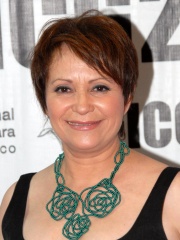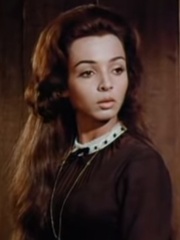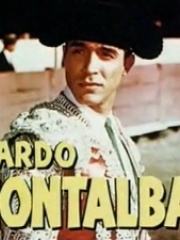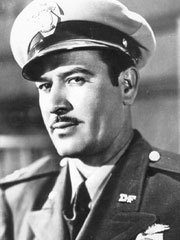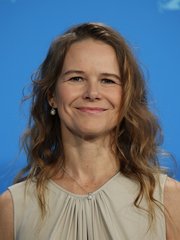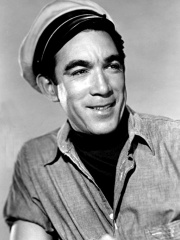

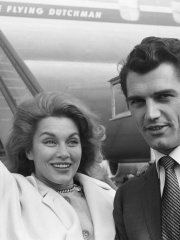
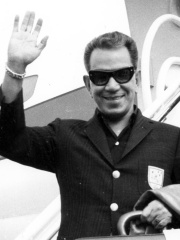
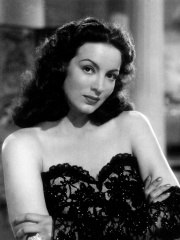
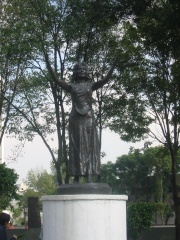
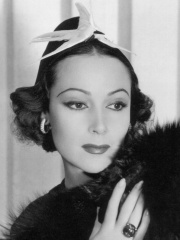
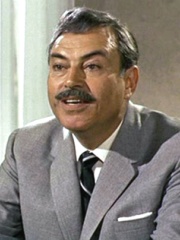
The Most Famous
ACTORS from Mexico
Top 10
The following people are considered by Pantheon to be the top 10 most legendary Mexican Actors of all time. This list of famous Mexican Actors is sorted by HPI (Historical Popularity Index), a metric that aggregates information on a biography's online popularity. Visit the rankings page to view the entire list of Mexican Actors.

1. Anthony Quinn (1915 - 2001)
With an HPI of 79.24, Anthony Quinn is the most famous Mexican Actor. His biography has been translated into 78 different languages on wikipedia.
Manuel Antonio Rodolfo Quinn Oaxaca (April 21, 1915 – June 3, 2001), known as Anthony Quinn, was an American actor. He was known for his portrayal of earthy, passionate characters "marked by a brutal and elemental virility" in over 100 film, television and stage roles between 1936 and 2002. He was a two-time Academy Award winner, and was also nominated for five Golden Globe Awards, two BAFTA Awards and a Tony Award. Quinn was born in Chihuahua City, Mexico, and was raised in El Paso, Texas and East Los Angeles. After stints as a boxer and an architect, he made his film debut in the Cecil B. DeMille Western The Plainsman in 1936. Initially typecast as a "heavy" and playing other minor parts as well, he was gradually cast in more substantial parts, including co-starring roles in Blood and Sand (1941) and The Ox-Bow Incident (1943). He won his first Oscar, for Best Supporting Actor, for his portrayal of Eufemio Zapata in Viva Zapata! (1952), becoming the first Mexican-born performer to win an Academy Award. He received his second Oscar in 1957 for Lust for Life. He would be nominated for Best Actor twice more, for his roles in Wild is the Wind (1958) and Zorba the Greek (1964). His other notable films included La Strada (1954), The Guns of Navarone (1961), Requiem for a Heavyweight (1962), Lawrence of Arabia (1962), Guns for San Sebastian (1968), The Shoes of the Fisherman (1968), Across 110th Street (1972), The Message (1976), Lion of the Desert (1980), Jungle Fever (1991) and Seven Servants (1996). He also starred in the Broadway plays A Streetcar Named Desire (replacing Marlon Brando), Becket (earning a Tony nomination for Best Actor in a Play), and Zorba (reprising his film role). Aside from his acting career, Quinn was also a civil rights activist, an avid painter, and the author of several autobiographical books. In 1987, he was presented with the Golden Globe Cecil B. DeMille Lifetime Achievement Award. Through both his artistic endeavors and activism, he is considered a seminal figure of Latin-American representation in the media of the United States.

2. Salma Hayek (b. 1966)
With an HPI of 71.47, Salma Hayek is the 2nd most famous Mexican Actor. Her biography has been translated into 88 different languages.
Salma Valgarma Hayek Pinault ( HY-ek, Spanish: [ˈsalma ˈxaʝek]; née Hayek Jiménez; born September 2, 1966) is a Mexican and American actress and film producer. She began her career in Mexico with starring roles in the telenovela Teresa (1989–1991) as well as the romantic drama Midaq Alley (1995). She soon established herself in Hollywood with appearances in films such as Desperado (1995), From Dusk till Dawn (1996), Wild Wild West (1999), and Dogma (1999). Hayek's portrayal of painter Frida Kahlo in the biopic Frida (2002), which she also produced, made her the first Mexican actress to be nominated for the Academy Award for Best Actress. In subsequent years, Hayek focused more on producing while starring in the action-centered pictures Once Upon a Time in Mexico (2003), After the Sunset (2004) and Bandidas (2006). She achieved further commercial success with the comedies Grown Ups (2010), Grown Ups 2 (2013) and The Hitman's Bodyguard (2017), and lent her voice for the animated Puss in Boots (2011), Sausage Party (2016) and Puss in Boots: The Last Wish (2022). She also earned critical acclaim for her performances in the dramas Tale of Tales (2015), Beatriz at Dinner (2017) and House of Gucci (2021). She played Ajak in the Marvel Cinematic Universe film Eternals (2021), which emerged as her highest-grossing live action film. Hayek's directing, producing and acting work on television has earned her four Emmy Awards nominations. She won the Daytime Emmy Award for Outstanding Directing in a Children Special for The Maldonado Miracle (2004) and received two Primetime Emmy Award nominations, one for Outstanding Guest Actress in a Comedy Series and the other for Outstanding Comedy Series, for her work on the ABC television comedy-drama Ugly Betty (2006–2010). She also produced and played Minerva Mirabal in the Showtime film In the Time of the Butterflies (2001) and guest-starred on the NBC comedy series 30 Rock (2009–2013). As a public figure, Hayek has been cited as one of Hollywood's most powerful and influential Latina actresses as well as one of the world's most beautiful women by various media outlets. Time magazine named her one of the 100 most influential people in the world in 2023. In 2021, she was honored with a star on the Hollywood Walk of Fame. She is married to business magnate François-Henri Pinault, with whom she has a daughter.

3. Linda Christian (1923 - 2011)
With an HPI of 68.21, Linda Christian is the 3rd most famous Mexican Actor. Her biography has been translated into 27 different languages.
Linda Christian (born Blanca Rosa Henrietta Stella Welter Vorhauer; November 13, 1923 – July 22, 2011) was a Mexican film actress who appeared in Mexican and Hollywood films. Her career reached its peak in the 1940s and 1950s. She played Mara in the last Johnny Weissmuller Tarzan film Tarzan and the Mermaids (1948). She is also noted for being the first Bond girl, appearing in a 1954 television adaptation of the James Bond novel Casino Royale. In 1963, she starred as Eva Ashley in an episode of The Alfred Hitchcock Hour titled "An Out for Oscar".

4. Cantinflas (1911 - 1993)
With an HPI of 68.15, Cantinflas is the 4th most famous Mexican Actor. His biography has been translated into 50 different languages.
Mario Fortino Alfonso Moreno Reyes (12 August 1911 – 20 April 1993), known by the stage name Cantinflas (Spanish pronunciation: [kanˈtiɱflas]), was a Mexican comedian, actor, and filmmaker. He is considered to have been the most widely accomplished Mexican comedian and is well known throughout Latin America and Spain. His humor, loaded with Mexican linguistic features of intonation, vocabulary, and syntax, is beloved in all the Spanish-speaking countries of Latin America and in Spain. His abilities gave rise to a range of expressions based on his stage name, including: cantinflear, cantinflada, cantinflesco, cantifleando and cantinflero. He often portrayed impoverished farmers or peasants of pelado origin. The character allowed Cantinflas to establish a long, successful film career that included a foray into Hollywood. Charlie Chaplin once commented that he was the best comedian alive, and Moreno has been referred to as the "Charlie Chaplin of Mexico". To audiences in most of the world, he is best remembered as co-starring with David Niven in the Oscar-winning film Around the World in 80 Days, for which Moreno won a Golden Globe Award for Best Actor – Motion Picture Musical or Comedy. As a pioneer of the cinema of Mexico, Moreno helped usher in its golden era. In addition to being a business leader, he also became involved in Mexico's complex labor politics. His reputation as a spokesperson for the working class gave his actions authenticity and became important in the early struggle against charrismo, the ruling PRI's practice of co-opting and controlling trade unions. Moreover, his character Cantinflas, whose identity became enmeshed with his own, was examined by media critics, philosophers, and linguists, who saw him variously as a danger to Mexican society, a bourgeois puppet, a verbal innovator, and a picaresque underdog.
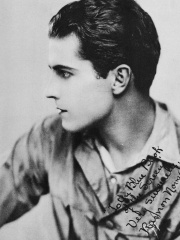
5. Ramon Novarro (1899 - 1968)
With an HPI of 67.46, Ramon Novarro is the 5th most famous Mexican Actor. His biography has been translated into 31 different languages.
Ramón Gil Samaniego (February 6, 1899 – October 30, 1968), known professionally as Ramon Novarro, was a Mexican actor. He began his career in American silent films in 1917 and eventually became a leading man and one of the top box-office attractions of the 1920s and early '30s. Novarro was promoted by MGM as a "Latin lover" and became known as a sex symbol after the death of Rudolph Valentino. He is recognized as the first Latin American actor to succeed in Hollywood.

6. María Félix (1914 - 2002)
With an HPI of 66.60, María Félix is the 6th most famous Mexican Actor. Her biography has been translated into 38 different languages.
María de los Ángeles Félix Güereña (Spanish: [maˈɾi.a ˈfeliɣs]; 8 April 1914 – 8 April 2002) was a Mexican actress and singer. Along with Pedro Armendáriz and Dolores del Río, she was one of the most successful figures of Latin American cinema in the 1940s and 1950s. Considered one of the most beautiful actresses of the Golden Age of Mexican cinema, her strong personality and taste for finesse garnered her the title of diva early in her career. She was known as La Doña, a name derived from her character in Doña Bárbara (1943), and María Bonita, thanks to the anthem composed exclusively for her as a wedding gift by her second husband, Agustín Lara. Her acting career consists of 47 films made in Mexico, Spain, France, Italy, and Argentina.

7. Silvia Pinal (1931 - 2024)
With an HPI of 66.60, Silvia Pinal is the 7th most famous Mexican Actor. Her biography has been translated into 32 different languages.
Silvia Pinal Hidalgo (12 September 1931 – 28 November 2024) was a Mexican actress. She began her career in theatre before venturing into cinema in 1949. She became one of the greatest female stars of the Golden Age of Mexican cinema and, with her performance in Shark! (1969), part of the Golden Age of Hollywood. Her work in film and popularity in her native country led Pinal to work in Europe, particularly in Spain and Italy. Pinal achieved international recognition by starring in a trilogy of films directed by Luis Buñuel: Viridiana (1961), The Exterminating Angel (1962) and Simon of the Desert (1965). In addition to her film career, Pinal pioneered musical theatre in Mexico, had a successful career in television, and held a series of public roles and political offices, including First Lady of Tlaxcala in the 1980s and elected terms in the Chamber of Deputies, the Assembly of Representatives of the Federal District, and the Senate of the Republic. She was considered "the last diva" of the Golden Age of Mexican film.

8. Dolores del Río (1905 - 1983)
With an HPI of 66.29, Dolores del Río is the 8th most famous Mexican Actor. Her biography has been translated into 48 different languages.
María de los Dolores Asúnsolo y López Negrete (3 August 1904 – 11 April 1983), known professionally as Dolores del Río (Spanish pronunciation: [doˈloɾes del ˈri.o]), was a Mexican actress. With a career spanning more than 50 years, she is regarded as the first major female Latin American crossover star in Hollywood. Along with a notable career in American cinema during the 1920s and 1930s, she was also considered one of the most important female figures in the Golden Age of Mexican cinema, and one of the most beautiful actresses of her era. After being discovered in Mexico, she began her film career in Hollywood in 1925. She had roles in a string of successful films, including Resurrection (1927), Ramona (1928) and Evangeline (1929). Del Río came to be considered a sort of feminine version of Rudolph Valentino, a ‘female Latin Lover’, in her years during the American silent era. With the advent of sound, she acted in a range of film genres, from contemporary crime melodramas to musical comedies and romantic dramas. Her most successful films of that decade include Bird of Paradise (1932), Flying Down to Rio (1933) and Madame Du Barry (1934). In the early 1940s, when her Hollywood career began to decline, Del Río returned to Mexico and joined the Mexican film industry, which at that time was at its peak, during the Golden Age of Mexican Cinema. When Del Río returned to her native country, she became one of the more important stars of the Golden Age of Mexican cinema. A series of Mexican films starring Del Rio are considered classic masterpieces and helped boost Mexican cinema worldwide. Of them stands out the critically acclaimed María Candelaria (1943). Del Río remained active mainly in Mexican films throughout the 1950s. In 1960 she returned to Hollywood. During the next years she appeared in Mexican and American films. From the late 1950s until the early 1970s she also successfully ventured into theater in Mexico and appeared in some American TV series. Del Río is considered a quintessential representation of the female face of Mexico in the world.

9. Pedro Armendáriz (1912 - 1963)
With an HPI of 66.06, Pedro Armendáriz is the 9th most famous Mexican Actor. His biography has been translated into 40 different languages.
Pedro Gregorio Armendáriz Hastings (May 9, 1912 – June 18, 1963) was a Mexican and American actor who made films in both Mexico and the United States. With the actresses Dolores del Río and María Félix, he was one of the best-known Latin American movie stars of the 1940s and 1950s.
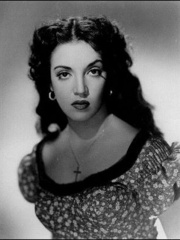
10. Katy Jurado (1924 - 2002)
With an HPI of 65.10, Katy Jurado is the 10th most famous Mexican Actor. Her biography has been translated into 38 different languages.
María Cristina Estela Marcela Jurado García (16 January 1924 – 5 July 2002), known professionally as Katy Jurado ( jə-RAH-doh, Spanish: [ˈkati xuˈɾaðo]), was a Mexican actress. She followed in the footsteps of earlier Mexican actresses in Hollywood; including Dolores Del Rio, Lupe Velez, and María Félix. And her talent for playing a variety of characters helped to promote later Mexican actresses in American cinema. She acted in popular Western films of the 1950s and 1960s. She was the first Latin American actress nominated for an Oscar, as Best Supporting Actress for her work in Broken Lance (1954), and was the first to win a Golden Globe Award, for her performance in High Noon (1952).
People
Pantheon has 164 people classified as Mexican actors born between 1895 and 2003. Of these 164, 127 (77.44%) of them are still alive today. The most famous living Mexican actors include Salma Hayek, Verónica Castro, and Laura Harring. The most famous deceased Mexican actors include Anthony Quinn, Linda Christian, and Cantinflas. As of April 2024, 24 new Mexican actors have been added to Pantheon including Eduardo Yáñez, Arturo Peniche, and Mayrín Villanueva.
Living Mexican Actors
Go to all RankingsSalma Hayek
1966 - Present
HPI: 71.47
Verónica Castro
1952 - Present
HPI: 63.45
Laura Harring
1964 - Present
HPI: 62.89
Sara Ramirez
1975 - Present
HPI: 62.68
Fernando Colunga
1966 - Present
HPI: 61.07
Jacqueline Andere
1938 - Present
HPI: 60.96
Demián Bichir
1963 - Present
HPI: 59.65
Adriana Barraza
1956 - Present
HPI: 59.56
Gael García Bernal
1978 - Present
HPI: 59.38
Adela Noriega
1969 - Present
HPI: 59.28
Victoria Ruffo
1962 - Present
HPI: 58.68
Ana Martín
1945 - Present
HPI: 58.52
Deceased Mexican Actors
Go to all RankingsAnthony Quinn
1915 - 2001
HPI: 79.24
Linda Christian
1923 - 2011
HPI: 68.21
Cantinflas
1911 - 1993
HPI: 68.15
Ramon Novarro
1899 - 1968
HPI: 67.46
María Félix
1914 - 2002
HPI: 66.60
Silvia Pinal
1931 - 2024
HPI: 66.60
Dolores del Río
1905 - 1983
HPI: 66.29
Pedro Armendáriz
1912 - 1963
HPI: 66.06
Katy Jurado
1924 - 2002
HPI: 65.10
Ricardo Montalbán
1920 - 2009
HPI: 64.93
Pedro Infante
1917 - 1957
HPI: 63.34
Chespirito
1929 - 2014
HPI: 63.23
Newly Added Mexican Actors (2025)
Go to all RankingsEduardo Yáñez
1960 - Present
HPI: 53.61
Arturo Peniche
1962 - Present
HPI: 51.67
Mayrín Villanueva
1970 - Present
HPI: 48.57
Alessandra Rosaldo
1971 - Present
HPI: 47.76
Nailea Norvind
1970 - Present
HPI: 47.07
Ana Patricia Rojo
1974 - Present
HPI: 46.19
Adriana Paz
1980 - Present
HPI: 45.78
Paty Navidad
1973 - Present
HPI: 44.94
Eréndira Ibarra
1985 - Present
HPI: 43.32
Vanessa Villela
1978 - Present
HPI: 43.23
Ana Claudia Talancón
1980 - Present
HPI: 43.20
José Luis Reséndez
1978 - Present
HPI: 42.28
Overlapping Lives
Which Actors were alive at the same time? This visualization shows the lifespans of the 25 most globally memorable Actors since 1700.







